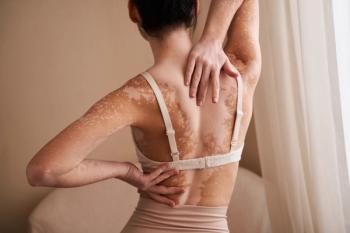
Role of Ruxolitinib in Vitiligo Treatment
Experts in dermatology discuss ruxolitinib, an exciting new therapy approved for repigmentation of the skin for patients with vitiligo.
Episodes in this series

David Rosmarin, MD: When I think of first-line options—topical corticosteroids [TCSs], topical calcineurin inhibitors [TCIs], and now ruxolitinib cream—it’s always interesting to ask other physicians, “What is the first regimen you give patients?” With topical corticosteroids, I’ll often start with that, especially if it’s on the body, but I try to avoid sensitive areas—the face, neck, axillae, groin. In areas where people have vitiligo, and even in those that may be a thicker like the trunk or extremities, I’ll still try to do intermittent treatment. Maybe once a day of the steroids, 1 week of the TCI, and then alternate.
There are a lot of regimens people use, whether they’re intermittent treatment or continuous. There’s no standard way that experts treat vitiligo. More recently, with the approval of ruxolitinib cream, particularly with strong data for monotherapy, I’ll offer that as well. Some patients may get corticosteroids and calcineurin inhibitors first, and some may get ruxolitinib cream first. If patients fail that, I’ll offer them ruxolitinib cream. How are you going about those first-line topical treatments?
Nada Elbuluk, MD: That’s a great question. Similar to you, I take into account the body location. I prefer TCIs for the face, intertriginous areas, and more sensitive areas and topical steroids for the body and the nonintertriginous sites. It’s all been a combination: use this on the face and something else on the body. I’ve started to move toward giving them a break on weekends. A lot of times I’ll have them do a Monday-to-Friday regimen because the toll of treatment is exhausting for patients. Every day they’re remembering to put on a cream once or twice a day in different locations plus phototherapy. Treatment burnout is a real thing too. Sometimes I say, “If you can be consistent Monday to Friday, you can take a break from the cream Saturday and Sunday.” That can help some people mentally.
I’m very excited about the JAK inhibitors and having another option that we could consider first line for patients and 1 that’s nonsteroidal and that we can use on those sensitive areas as well. I mention it to my patients as a first-line option. I still use a lot of our traditional things. But for a lot of patients who’ve been on those and who haven’t fully repigmented, I’ve switched a lot of them to ruxolitinib. Sometimes I have patients who come in and have already heard about ruxolitinib. They’re excited and want to try that specifically. I’m open to that if they feel strongly that they want to go right to that. That’s how I’ve been incorporating that. I’ve been pleased with it so far. I have a lot of patients still doing phototherapy also, although it can be done as a monotherapy. Some early data show that some people have additive or improved response by doing a JAK inhibitor with the phototherapy. I’m doing that as well.
David Rosmarin, MD: I have a lot of patients who come in asking for ruxolitinib cream specifically. I feel comfortable using all 3 topical options as initial treatment. That’s consistent with the package insert, which describes ruxolitinib cream for those who are 12 years of age and older with nonsegmental vitiligo. There’s no precondition for failing other treatment first, which is helpful. It’s a favorable label in that regard.
Usually, when I tell patients what to expect with the use of the cream, I tell them that it’s better to use it twice a day. We have data that even once a day can help repigment patients, but twice a day certainly works better. I tell them to be patient with it. I usually see patients back in 6 months. I don’t do any lab work beforehand with the ruxolitinib cream because with the phase 3 data, we weren’t seeing significant changes in lab abnormalities. Those were checked during the studies. I tell patients that half of those who use the cream will get 75% or more of pigment back on their face, and half will get 50% or more of their pigment back on the body.
Commonly, people ask, “I’ve tried some other things before. Does that mean I have less of a chance of this working?” In the subgroup analysis, that’s not the case. Patients who were naïve or who used phototherapy, TCI, or TCS had similar responses for repigmentation. Also, race and age are factors. What’s shocking to me is the duration of the vitiligo. Patients who’ve had it for over 50 years responded similarly well to patients who had it for a few months. It’s important to realize that despite that clinical characteristic and baseline demographics, patients respond similarly well.
However, anatomic location, as with all our treatments, affects prognosis. When patients have the head and neck affected, we have a better and an earlier response. With trunk and extremities, we can still get good responses as well. But when it comes to acral sites like hands and feet, you can see some response, but it’s more challenging and takes longer. I try to rest expectations around those sites. That’s important. Do you change your counseling base on the anatomic location where patients have their disease?
Nada Elbuluk, MD: Yes, it’s important to tell patients from the get-go about that. I tell them the face is 1 of the best places to repigment. It tends to have a nice response, even in areas like the eyelids. I warn them that hands and feet, particularly more distally, are a challenge and can be harder to treat. If acrofacial lip tip vitiligo is their predominant presentation, I go even deeper into that conversation. It’s important to set expectations. It doesn’t mean that we can’t try treatment options and see how they do. I prepare them for that. Similarly, with certain special sites, like nipples and genitals, it can be a challenge. In some of those areas, we’re not doing phototherapy. I let them know that the treatment response rate may not be as high. As I mentioned, we can try treatments.
David Rosmarin, MD: Another question that I commonly get is, how do you address a patient in terms of the black-box warning for the topical ruxolitinib cream? It has that JAK inhibitor black-box warning. How do you describe that to your patients?
Nada Elbuluk, MD: I let them know that that warning is there based on what was found with the oral JAK inhibitor data, and that topically, the clinical trial data have been supportive in terms of its safety and efficacy. You have to know their background history. Are they at higher risk for anything we still need to monitor? The absorption from the topical is much less than what people are getting orally. Even though that warning had to be on there, it’s not something they need to be significantly concerned about.
David Rosmarin, MD: I certainly describe the black-box warning to patients. It’s important to disclose it. But I put it in the context that this was seen for the systemic agents, and the reason why we’re giving you a topical is to try to mitigate those risks.
Nada Elbuluk, MD: Right.
David Rosmarin, MD: The vast majority of patients understand that the risk isn’t the same with a topical as it is with a systemic.
Nada Elbuluk, MD: Correct.
David Rosmarin, MD: It’s important to go over it with all patients.
Transcript edited for clarity
Newsletter
Like what you’re reading? Subscribe to Dermatology Times for weekly updates on therapies, innovations, and real-world practice tips.


















